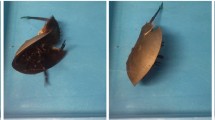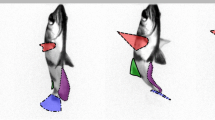Abstract
A portable tomographic particle image velocimetry (tomographic PIV) system is described. The system was successfully deployed in Antarctica to study shelled Antarctic pteropods (Limacina helicina antarctica)—a delicate organism with an unusual propulsion mechanism. The experimental setup consists of a free-standing frame assembled with optical rails, thus avoiding the need for heavy and bulky equipment (e.g. an optical table). The cameras, lasers, optics, and tanks are all rigidly supported within the frame assembly. The results indicate that the pteropods flap their parapodia (or “wings”) downward during both power and recovery strokes, which is facilitated by the pitching of their shell. Shell pitching significantly alters the flapping trajectory, allowing the pteropod to move vertically and/or horizontally. The pronation and supination of the parapodia, together with the figure-eight motion during flapping, suggest similarities with insect flight. The volumetric velocity field surrounding the freely swimming pteropod reveals the generation of an attached vortex ring connecting the leading-edge vortex to the trailing-edge vortex during power stroke and a presence of a leading-edge vortex during recovery stroke. These vortex structures play a major role in accelerating the organism vertically and indicate that forces generated on the parapodia during flapping constitute both lift and drag. After completing each stroke, two vortex rings are shed into the wake of the pteropod. The complex combination of body kinematics (parapodia flapping, shell pitch, sawtooth trajectory), flow structures, and resulting force balance may be significantly altered by thinning of the pteropod shell, thus making pteropods an indicator of the detrimental effects of ocean acidification.













Similar content being viewed by others
References
Adhikari D, Longmire EK (2012) Visual hull method for tomographic PIV measurement of flow around moving objects. Exp Fluids 53:943–964
Adhikari D, Longmire EK (2013) Infrared tomographic PIV and 3D motion tracking system applied to aquatic predator-prey interaction. Meas Sci Technol 24:024011
Adhikari D, Gemmell BJ, Hallberg MP, Longmire EK, Buskey EJ (2015) Simultaneous measurement of 3D zooplankton trajectories and surrounding fluid velocity field in complex flows. J Exp Biol 218:3534–3540
Bednaršek N, Tarling GA, Bakker DCE, Fielding S, Jones EM, Venables HJ, Ward P, Kuzirian A, Lézé B, Feely RA, Murphy EJ (2012) Extensive dissolution of live pteropods in the Southern Ocean. Nat Geosci 5:881–885
Casey TA, Sakakibara J, Thoroddsen ST (2013) Scanning tomographic particle image velocimetry applied to a turbulent jet. Phys Fluids 25:025102
Catton KB, Webster DR, Brown J, Yen J (2007) Quantitative analysis of tethered and free-swimming copepodid flow fields. J Exp Biol 210:299–310
Catton KB, Webster DR, Kawaguchi S, Yen J (2011) The hydrodynamic disturbances of two species of krill: implications for aggregation structure. J Exp Biol 214:1845–1856
Chang Y, Yen J (2012) Swimming in the intermediate Reynolds range: kinematics of the pteropod Limacina helicina. Integr Comp Biol 52:597–615
Cheng JY, DeMont ME (1996) Hydrodynamics of scallop locomotion: unsteady fluid forces on clapping shells. J Fluid Mech 317:73–90
Childress S, Dudley R (2004) Transition from ciliary to flapping mode in a swimming mollusc: flapping flight as a bifurcation in Re ω . J Fluid Mech 498:257–288
Comeau S, Alliouane S, Gattuso J-P (2012) Effects of ocean acidification on overwintering juvenile Arctic pteropods Limacina helicina. Mar Ecol Prog Ser 456:279–284
Dabiri JO, Colin SP, Costello JH (2006) Fast-swimming hydromedusae exploit velar kinematics to form an optimal vortex wake. J Exp Biol 209:2025–2033
Elsinga GE, Scarano F, Wieneke B, van Oudheusden BW (2006) Tomographic particle image velocimetry. Exp Fluids 41:933–947
Flammang BE, Lauder GV, Troolin DR, Strand TE (2011) Volumetric imaging of fish locomotion. Biol Lett 7:695–698
Fuchiwaki M, Kuroki T, Tanaka K, Tababa T (2013) Dynamic behavior of the vortex ring formed on a butterfly wing. Exp Fluids 54:1450
Gattuso J-P, Hansson L (2011) Ocean acidification: Background and history. In: Gattuso J-P, Hansson L (eds) Ocean acidification. Oxford University Press, New York, pp 1–20
Gonzalez RC, Woods RE (2002) Digital image processing, 2nd edn. Prentice-Hall, New Jersey
Hedrick TL (2008) Software techniques for two- and three-dimensional kinematic measurements of biological and biomimetic systems. Bioinspir Biomim 3:034001
Howes EL, Bednaršek N, Büdenbender J, Comeau S, Doubleday A, Gallager SM, Hopcroft RR, Lischka Maas AE, Bijma J, Gattuso JP (2014) Sink and swim: a status review of thecosome pteropod culture techniques. J Plankton Res 36:299–315
Izraelevitz JS, Triantafyllou MS (2014) Adding in-line motion and model-based optimization offers exceptional force control authority in flapping foils. J Fluid Mech 742:5–34
Kida S, Takaoka M (1994) Vortex reconnection. Annu Rev Fluid Mech 26:169–189
Langley KR, Hardester E, Thomson SL, Truscott TT (2014) Three-dimensional flow measurements on flapping wings using synthetic aperture PIV. Exp Fluids 55:1831
Lauder GV (2015) Fish locomotion: recent advances and new directions. Annu Rev Mar Sci 7:521–545
Lauga E, Powers TR (2009) The hydrodynamics of swimming microorganisms. Rep Prog Phys 72:096601
Lehmann F-O, Pick S (2007) The aerodynamic benefit of wing-wing interaction depends on stroke trajectory in flapping insect wings. J Exp Biol 210:1362–1377
Lighthill MJ (1973) On the Weis-Fogh mechanism of lift generation. J Fluid Mech 60:1–17
Malkiel E, Sheng J, Katz J, Strickler JR (2003) The three-dimensional flow field generated by a feeding calanoid copepod measured using digital holography. J Exp Biol 206:3657–3666
Manno C, Morata N, Primicerio R (2012) Limacina retroversa’s response to combined effects of ocean acidification and sea water freshening. Estuar Coast Shelf Sci 113:163–171
Mendelson L, Techet AH (2015) Quantitative wake analysis of a freely swimming fish using 3D synthetic aperture PIV. Exp Fluids 56:135
Murphy DW, Webster DR, Yen J (2012) A high-speed tomographic PIV system for measuring zooplankton flow. Limnol Oceanogr Methods 10:1096–1112
Murphy DW, Webster DR, Yen J (2013) The hydrodynamics of hovering in Antarctic krill. Limnol Oceanogr Fluids Environ 3:240–255
Murphy DW, Adhikari D, Webster DR, Yen J (2016) Underwater flight by the planktonic sea butterfly. J Exp Biol 216:535–543
Orr JC, Fabry VJ, Aumont O, Bopp L, Doney SC, Feely RA, Gnanadesikan A, Gruber N, Ishida A, Joos F, Key RM, Lindsay K, Maier-Reimer E, Matear R, Mouchet A, Najjar RG, Plattner GK, Rodgers KB, Sabine CL, Sarmiento JL, Schlitzer R, Slater RD, Totterdell IJ, Weirig MF, Yamanaka Y, Yool A (2005) Anthropogenic ocean acidification over the twenty-first century and its impact on calcifying organisms. Nature 437:681–686
Saffman PG (1990) A model of vortex reconnection. J Fluid Mech 212:395–402
Scarano F, Poelma C (2009) Three-dimensional vorticity patterns of cylinder wakes. Exp Fluids 47:69–83
Sutherland KR, Madin LP (2010) Comparative jet wake structure and swimming performance of salps. J Exp Biol 213:2967–2975
Wang ZJ (2005) Dissecting insect flight. Annu Rev Fluid Mech 37:183–210
Weis-Fogh T (1973) Quick estimates of flight fitness in hovering animals, including novel mechanisms for lift production. J Exp Biol 59:169–230
Wieneke B (2008) Volume self-calibration for 3D particle image velocimetry. Exp Fluids 45:549–556
Acknowledgements
We thank the United States Antarctic Program for their support on RV Laurence M. Gould and at Palmer Station, Antarctica, that made this study successful. We gratefully acknowledge Dr. David Fields (Bigelow Laboratory for Ocean Sciences), Dr. Roi Holzman (Tel Aviv University), Dr. Rajat Mittal (Johns Hopkins University), Dr. Marc Weissburg (Georgia Institute of Technology), and Dr. Jun Zhang (New York University) for many fruitful discussions and their help in collecting pteropods in Antarctica. This work is supported by the US National Science Foundation (PLR-1246296).
Author information
Authors and Affiliations
Corresponding author
Electronic supplementary material
Below is the link to the electronic supplementary material.
Rights and permissions
About this article
Cite this article
Adhikari, D., Webster, D.R. & Yen, J. Portable tomographic PIV measurements of swimming shelled Antarctic pteropods. Exp Fluids 57, 180 (2016). https://doi.org/10.1007/s00348-016-2269-7
Received:
Revised:
Accepted:
Published:
DOI: https://doi.org/10.1007/s00348-016-2269-7




